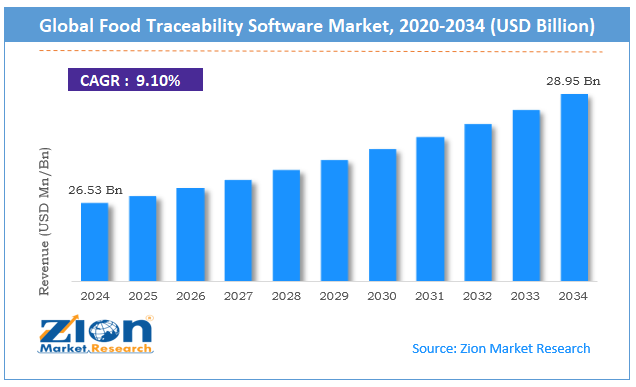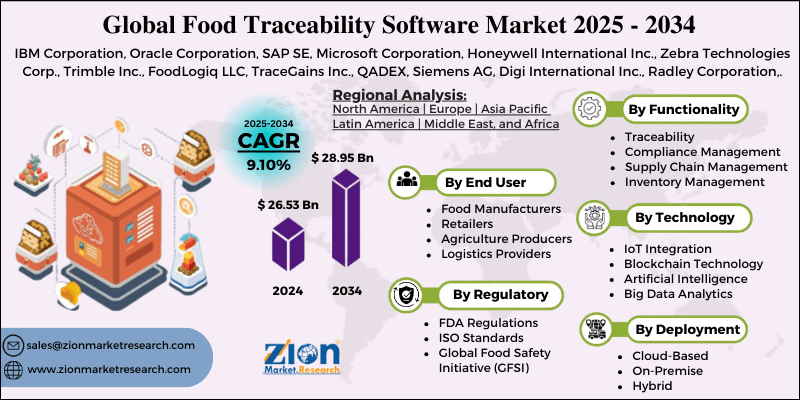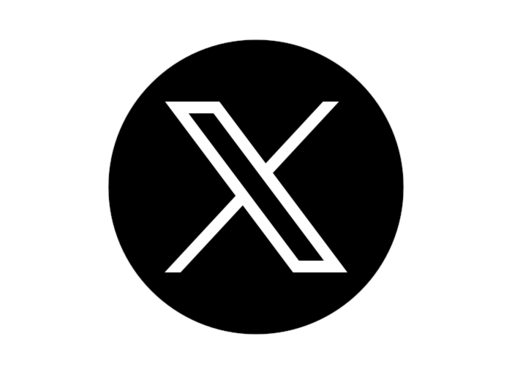Food Traceability Software Market Size, Share, Trends, Growth and Forecast 2034

Food Traceability Software Market By Software Deployment Model (Cloud-Based, On-Premise, and Hybrid), By Functionality (Traceability, Compliance Management, Supply Chain Management, and Inventory Management), By End User (Food Manufacturers, Retailers, Agriculture Producers, and Logistics Providers), By Technology Integration (IoT Integration, Blockchain Technology, Artificial Intelligence, and Big Data Analytics), By Regulatory Standards (FDA Regulations, ISO Standards, Global Food Safety Initiative (GFSI), and HACCP Regulations), and By Region - Global and Regional Industry Overview, Market Intelligence, Comprehensive Analysis, Historical Data, and Forecasts 2025 - 2034
| Market Size in 2024 | Market Forecast in 2034 | CAGR (in %) | Base Year |
|---|---|---|---|
| USD 26.53 Billion | USD 28.95 Billion | 9.10% | 2024 |
Food Traceability Software Industry Prospective:
The global food traceability software market size was valued at approximately USD 26.53 billion in 2024 and is expected to reach around USD 28.95 billion by 2034, growing at a compound annual growth rate (CAGR) of roughly 9.10% between 2025 and 2034.
Food Traceability Software Market: Overview
Food traceability software consists of digital platforms, data management systems, tracking apps, and analytical tools that allow food businesses to track products throughout the supply chain without interruptions. This enables transparency and accountability in food production and distribution so people can see where their food comes from and if it's safe. Food traceability software has changed many industries' quality assurance, recall management, and consumer communication.
Food traceability software is the foundation of modern food safety systems, giving access to origin verification, contamination prevention, compliance documentation, and monitoring so businesses can manage regulatory requirements in daily operations and avoid costly recalls. Increasing food safety regulations, supply chain complexity, and consumer demand for transparency drive the food traceability software market.
Over the forecast period, expanding blockchain implementations, integrated sensor technologies, predictive analytics applications, and compliance automation across many geographies will drive the food traceability software market.
Key Insights:
- As per the analysis shared by our research analyst, the global food traceability software market is estimated to grow annually at a CAGR of around 9.10% over the forecast period (2025-2034)
- In terms of revenue, the global food traceability software market size was valued at around USD 26.53 billion in 2024 and is projected to reach USD 28.95 billion by 2034.
- The food traceability software market is projected to grow significantly due to increasing regulatory requirements for food safety, rising consumer demand for transparency, growth in foodborne illness concerns requiring rapid response capabilities, and expanding digital transformation initiatives enhancing supply chain visibility.
- Based on the software deployment model, cloud-based solutions lead the segment and will continue to dominate the global market.
- Based on functionality, traceability features are anticipated to command the largest market share by the end of the forecast period.
- Based on end users, food manufacturers are expected to lead the market during the forecast period.
- Based on technology integration, blockchain technology will remain dominant during the forecast period.
- Based on regulatory standards, FDA regulations will dominate the global market during the forecast period.
- Based on region, North America is projected to dominate the global market during the forecast period.
Food Traceability Software Market: Growth Drivers
Rising regulatory compliance and recall mitigation
In the food traceability software market, with food safety regulations rising, there's more focus on products that deliver complete compliance documentation. Businesses are looking for traceability solutions that offer automated record-keeping, real-time monitoring, and rapid response to help them manage risk.
According to recent industry surveys, food companies are investing more in traceability solutions, and recall-related cost avoidance has increased proportionally. Growing business demand for integrated compliance solutions and automated reporting is driving market trends.
Supply chain visibility and consumer trust enhancement
Technology drives the food traceability software industry, with developers adding features like QR code integration, mobile verification apps, and end-consumer transparency tools. Modern food traceability software now offers farm-to-fork tracking, ethical sourcing verification, and consumer confidence.
New food traceability software purchases are driven by consumer demand for transparency, and origin verification is one of the top three features requested. Integrating sustainability metrics and ethical sourcing documentation helps build brand reputation and consumer loyalty.
Food Traceability Software Market: Restraints
Implementation complexity and legacy system integration challenges
Technical barriers, integration challenges, and learning curves are significant hurdles in the food traceability software market. Developers must adapt to different technical infrastructures as supply chains are fragmented and interoperability issues are growing.
According to market reports, food companies say technical implementation is the first barrier to market adoption, especially for systems requiring multi-stakeholder participation across different geographies.
Food Traceability Software Market: Opportunities
Integration of predictive analytics and artificial intelligence
Preventative quality management and contamination prediction are transforming the food traceability software industry by providing better risk assessment, fewer recalls, and aligning with a proactive safety approach. AI-powered food traceability software can now deliver predictive insights beyond traditional tracking, with prevention capabilities and less reactive interventions.
Food Traceability Software Market: Challenges
Data standardization issues and interoperability constraints
The food traceability software industry is moving forward, but system fragmentation and growing technical complexity are massive barriers to entry. Implementers cite incompatible data formats as the number one reason for hesitation.
Supply chain diversity and cross-border traceability verification make building universal solutions hard. Many regions have different traceability standards that impact software architecture and deployment models.
As businesses prioritize smooth operations, the demand for standardized, interoperable traceability systems that balance traceability and operational efficiency will grow.
Food Traceability Software Market: Report Scope
| Report Attributes | Report Details |
|---|---|
| Report Name | Food Traceability Software Market |
| Market Size in 2024 | USD 26.53 Billion |
| Market Forecast in 2034 | USD 28.95 Billion |
| Growth Rate | CAGR of 9.10% |
| Number of Pages | 211 |
| Key Companies Covered | IBM Corporation, Oracle Corporation, SAP SE, Microsoft Corporation, Honeywell International Inc., Zebra Technologies Corp., Trimble Inc., FoodLogiq LLC, TraceGains Inc., QADEX, Siemens AG, Digi International Inc., Radley Corporation, Carlisle Technology, Blue Link Associates Limited, BatchMaster Software, WiseRFID Technologies, SoftTrace Ltd., Wherefour Inc., ReposiTrak Inc, and others. |
| Segments Covered | By Software Deployment Model, By Functionality, By End User, By Technology Integration, By Regulatory Standards, and By Region |
| Regions Covered | North America, Europe, Asia Pacific (APAC), Latin America, Middle East, and Africa (MEA) |
| Base Year | 2024 |
| Historical Year | 2019 to 2023 |
| Forecast Year | 2025 - 2034 |
| Customization Scope | Avail customized purchase options to meet your exact research needs. Request For Customization |
Food Traceability Software Market: Segmentation
The global food traceability software market is segmented into software deployment model, functionality, end user, technology integration, regulatory standards, and region.
Based on the software deployment model, the food traceability software industry is segregated into cloud-based, on-premise, and hybrid. Cloud-based solutions lead the market by offering enhanced accessibility, scalability benefits, and collaborative capabilities.
Based on functionality, the market is classified into traceability, compliance management, supply chain management, and inventory management. Traceability features are expected to lead the market during the forecast period, as these capabilities provide superior tracking precision, comprehensive documentation, and robust recall management that enhances operational safety.
Based on the end user, the food traceability software industry is categorized into food manufacturers, retailers, agriculture producers, and logistics providers. Food manufacturers are expected to lead the market since they bear primary responsibility for product safety and regulatory compliance.
Based on technology integration, the industry is segregated into IoT integration, blockchain technology, artificial intelligence, and big data analytics. Blockchain technology leads the market due to the widespread adoption of immutable ledger solutions for enhanced transparency and trust verification.
Based on regulatory standards, the market is divided into FDA regulations, ISO standards, Global Food Safety Initiative (GFSI), and HACCP regulations. FDA regulations are expected to dominate the market by establishing mandatory traceability requirements for food businesses in the United States.
Food Traceability Software Market: Regional Analysis
North America to lead the market
North America leads the global food traceability software market due to its strict regulatory environment, frequent recalls driving prevention, and robust technology infrastructure in the U.S. and Canada.
The U.S. accounts for 42% of global food traceability software adoption, as compliance requirements are deeply embedded in the business operating environment. The region has deep technology expertise and venture capital investment, which has built innovation capacity and solution development in specialized traceability applications.
Big software companies like IBM Food Trust, Oracle, and FoodLogiq have significant regional presence and implementation partnerships to ensure rapid deployment and industry adoption. North American food companies allocate more of their budget to food safety technologies than their global counterparts, so the compliance technology sector is thriving. North America also has a favorable venture capital environment for food-tech startups, driving the market. Strong digital ecosystem and cloud infrastructure drive food traceability software adoption across all industry segments.
Moreover, the growing use of AI-powered predictive analytics, blockchain-integrated supply chain solutions, and IoT-enabled monitoring systems enhances real-time tracking and contamination prevention. Increasing consumer demand for transparency and sustainability further pushes food companies to adopt end-to-end traceability solutions, strengthening regulatory compliance and operational efficiency.
Asia Pacific is set to grow significantly.
Asia Pacific is growing fast in the food traceability software industry, driven by the expanding export focus, intensifying food safety concerns, and digitalization of agricultural supply chains. Countries like India, Japan, and South Korea are developing national traceability standards and expanding the market for compliance-focused technology adoption. Southeast Asian countries have seen 29% annual growth in blockchain traceability being incorporated into agricultural exports.
The region's focus on contamination prevention and international trade compliance drives the development of solutions that combine global standards with local implementation approaches, especially in countries with established agricultural export industries.
Additionally, increasing government initiatives, rising consumer demand for transparency, and advancements in AI-powered analytics are accelerating the adoption of food traceability software.
Recent Market Developments:
- In February 2025, IBM Food Trust expanded its blockchain traceability platform with the Advanced Analytics Suite and Compliance Automation Engine, targeting the complex documentation needs of multi-tier supply chains.
- In March 2025, Oracle introduced the all-new Food Guardian Platform, an end-to-end traceability solution with AI-powered contamination prediction capabilities, setting new benchmarks for preventative safety management.
Food Traceability Software Market: Competitive Analysis
The global food traceability software market is led by players like
- IBM Corporation
- Oracle Corporation
- SAP SE
- Microsoft Corporation
- Honeywell International Inc.
- Zebra Technologies Corp.
- Trimble Inc.
- FoodLogiq LLC
- TraceGains Inc.
- QADEX
- Siemens AG
- Digi International Inc.
- Radley Corporation
- Carlisle Technology
- Blue Link Associates Limited
- BatchMaster Software
- WiseRFID Technologies
- SoftTrace Ltd.
- Wherefour Inc.
- ReposiTrak Inc
The global food traceability software market is segmented as follows:
By Software Deployment Model
- Cloud-Based
- On-Premise
- Hybrid
By Functionality
- Traceability
- Compliance Management
- Supply Chain Management
- Inventory Management
By End User
- Food Manufacturers
- Retailers
- Agriculture Producers
- Logistics Providers
By Technology Integration
- IoT Integration
- Blockchain Technology
- Artificial Intelligence
- Big Data Analytics
By Regulatory Standards
- FDA Regulations
- ISO Standards
- Global Food Safety Initiative (GFSI)
By Region
-
North America
- The U.S.
- Canada
- Europe
- France
- The UK
- Spain
- Germany
- Italy
- Rest of Europe
- Asia Pacific
- China
- Japan
- India
- South Korea
- Southeast Asia
- Rest of Asia Pacific
- Latin America
- Brazil
- Mexico
- Rest of Latin America
- Middle East & Africa
- GCC
- South Africa
- Rest of Middle East & Africa
Table Of Content
Methodology
FrequentlyAsked Questions
Food traceability software consists of digital platforms, data management systems, tracking apps, and analytical tools that allow food businesses to track products throughout the supply chain without interruptions.
The food traceability software market is expected to be driven by increasing regulatory requirements for food safety documentation, rising consumer demand for product transparency, technological advancements enabling real-time monitoring, expansion of blockchain verification capabilities, and growing food fraud concerns driving authentication solutions.
According to our study, the global food traceability software market was worth around USD 26.53 billion in 2024 and is predicted to grow to around USD 28.95 billion by 2034.
The CAGR value of the food traceability software market is expected to be around 9.10% during 2025-2034.
The global food traceability software market will register the highest growth in North America during the forecast period.
Key players in the food traceability software market include IBM Corporation, Oracle Corporation, SAP SE, Microsoft Corporation, Honeywell International Inc., Zebra Technologies Corp., Trimble Inc., FoodLogiq, LLC, TraceGains, Inc., QADEX, Siemens AG, Digi International Inc., Radley Corporation, Carlisle Technology, Blue Link Associates Limited, BatchMaster Software, WiseRFID Technologies, SoftTrace Ltd., Wherefour, Inc., and ReposiTrak, Inc.
The report comprehensively analyses the food traceability software market, including an in-depth discussion of market drivers, restraints, emerging trends, regional dynamics, and future growth opportunities. It also examines competitive dynamics, technological innovations, the evolving landscape of solution architectures, business implementation challenges, and regulatory requirements shaping the food traceability ecosystem.
HappyClients
Zion Market Research
Tel: +1 (302) 444-0166
USA/Canada Toll Free No.+1 (855) 465-4651
3rd Floor,
Mrunal Paradise, Opp Maharaja Hotel,
Pimple Gurav, Pune 411061,
Maharashtra, India
Phone No +91 7768 006 007, +91 7768 006 008
US OFFICE NO +1 (302) 444-0166
US/CAN TOLL FREE +1 (855) 465-4651
Email: sales@zionmarketresearch.com
We have secured system to process your transaction.
Our support available to help you 24 hours a day, five days a week.
Monday - Friday: 9AM - 6PM
Saturday - Sunday: Closed







